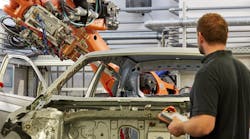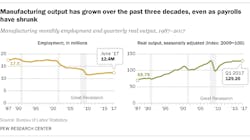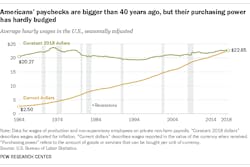The Current State of Manufacturing and Employment in the U.S.
Even as jobs continue to shift from the U.S. to foreign countries, we are using technology such as the Industrial Internet of Things (IIoT), automation, and robotics to reshore positions in this country. However, while these technologies are indeed increasing jobs, there may be cause for concern in the future.
I’ve written many articles on how technology increases jobs by decreasing costs, not only reshoring jobs but grow companies, which in turn promotes more jobs. I still agree with the idea that technology is good and does increase jobs. However, looking at PEW Research Centers statistics and taking some notes from Dartmouth business school professor Richard D’Aveni’s recently published The Pan-Industrial Revolution, we need to keep an eye on how we manage manufacturing going forward to avoid losing some of our market size—and by association, our jobs.
Courtesy of PEW Research
PEW Research stated in an article on August this year that this should be a great time for workers. Unemployment is as low as it’s been in nearly two decades (3.9% as of July), and the nation’s private-sector employers have been adding jobs for 101 months straight. Another article PEW published in July 2017 mentioned that manufacturing output has grown over the last three decades.
However, while PEW has seen 30 years of increased output from manufacturers, it also documented that manufacturers have decreased jobs and payroll. In addition, considering inflation, manufacturing wages have the same buying power as 40 years ago. As I’ve said it before, automation helps less people do more, which is supposed to increase a company’s growth and lead to more jobs, not less. Unfortunately, PEW’s research and the Bureau of Labor Statistics aren’t supporting this.
Courtesy of PEW Research
According to Fortune.com, taking data from Deloitte and U.S. Council on Competitiveness, the U.S. will become the biggest manufacturing power house again by 2020. While this is positive news the data from PEW shows that being number one again, doesn’t necessarily relate to more jobs and higher salaries for workers.
Furthermore, while a good read (and I suggest getting a copy), The Pan-Industrial Revolution didn’t make me feel any more comfortable. Confirming what I believe to be a disturbing trend for the U.S., Richard D’Aveni paints a picture of manufacturing on the world stage of today and the one beyond 2020. Today, IIoT, robotics, and 3D printing is disrupting cost-effective foreign labor and reshoring U.S. jobs. However, as the technologies become more accessible and affordable, these same countries will adopt the same equipment and start to look competitive again.
The new book from Dartmouth business school professor Richard D’Aveni investigates how companies are using 3D printing and how it will change manufacturing.
In addition, some of these countries don’t have the skills gap present in the U.S. One of the biggest problems hindering company growth today is not access to technology, but finding the right people to fill positions. This is a large driver of the automation boom. While robots and advanced automation are helping to mitigate the skills gap, without a solution we will only have shortage of even higher skilled jobs as automation increases.
Meanwhile, companies like HP are launching 3D printing centers in Asia and India. China specifically is investing heavily in technology and 3D printing. For years, companies have kept technologies such as 3D printing in foreign countries as a hidden ace up their sleeve. With new companies in these countries popping up, and older companies driving education and resources centers, the Pan-industrial revolution is starting to surface.
Volkswagen is integrating HP’s new Metal Jet 3D printer into its long-term design and production roadmap. This will increase Volkswagen’s ability to increase its digital manufacturing, time-to-market, flexibility, and customization. Finally, to ensure a robust supply chain of quality powder Volkswagen and HP have teamed with GKN Powder Metals. (Image courtesy of HP)
3D printing and automation offers flexibility, customization, and fast time-to-market, which is increasingly important in manufacturing. As accessibility and costs are reduced, industry should keep an eye on companies obtaining these technologies, making sure they have a consistent robust supply chain, fast delivery, and are in an area with a cost-effective labor that has the right skills.
It’s not all bad news. In June of this year, USA Today published an article that shows the U.S. still has many manufacturing values. The article shows which companies are bringing back jobs to the U.S., which is a sign our size, labor rates, and technology are cost-competitive with foreign markets. Again, it might not relate to jobs, or workers earning, but if manufacturers manage facilities right this growth could benefit workers.
As automation and 3D printing breathe life into digital manufacturing, it will be easier to decentralize manufacturing. Instead of one large factory, there can be multiple smaller local plants. This reduces delivery time and shipping, and might greatly help boost local jobs and economies. However, labor costs will still drive the location of the decentralized plants. If wages are too high in the U.S., it might be easier to continue shipping from foreign countries.
Also, other countries are developing at a faster rate than the U.S. While this isn’t currently a big concern, given the relative size of the U.S., it does mean the U.S. market as a whole might not be as in the future. Among the factors to watch for:
- Market size
- Labor force skills
- Labor cost
- Location
Taking these factors and splitting the difference between them to find the most effective location for a decentralized plant, companies may start to gravitate away from the U.S. as foreign markets continue to develop.
While we see companies growing, automation booming, and jobs reshoring, we should consider the income, benefits, and future of the people working in those factories. Manufacturing is a global competition, and if technology continues to advance we will have to find a way to collaborate with our neighbors before that competition leads to limited resources. Historically, it has been shown that mismanagement of resources breeds instability and war.
Today, the best way to keep the peace and delay the Pan-Industrial Revolution may be to focus on filling the skills gap, keeping people employed, manufacturers growing, and the U.S. economy strong.





